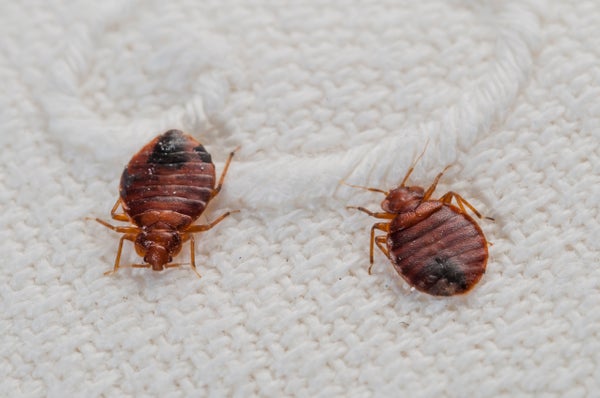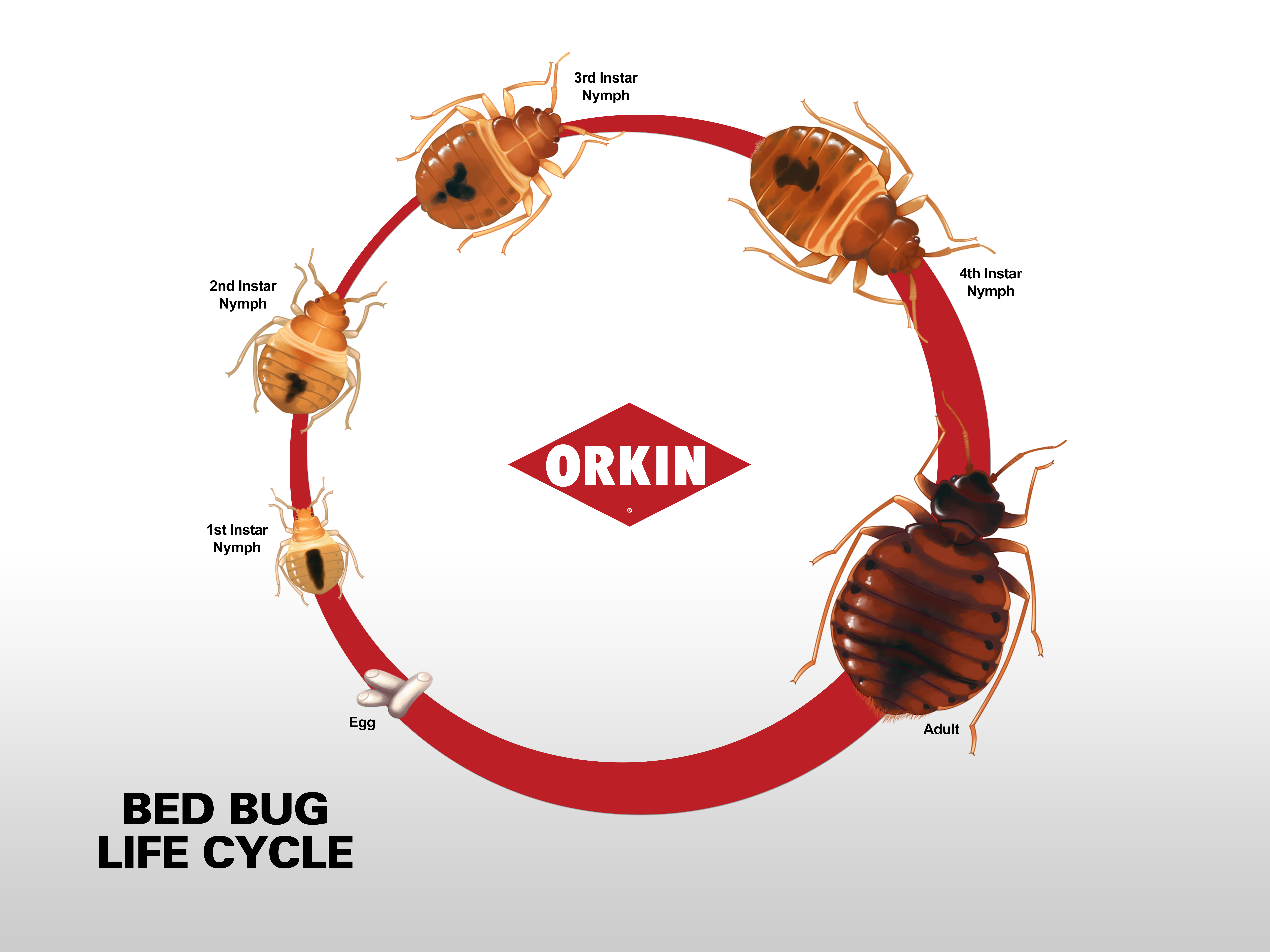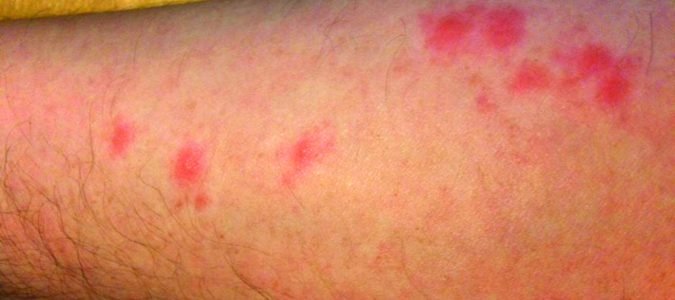Bed bugs can show up within a week after a new infestation takes root in your home. These tiny pests can be difficult to detect initially due to their nocturnal nature and ability to hide in small cracks and crevices.
If you have recently been exposed to bed bugs or suspect their presence, it’s crucial to act quickly to prevent a full-blown infestation. Early detection and timely intervention are key to effectively managing a bed bug problem. We will explore how long it takes for bed bugs to show up, signs to look out for, and steps you can take to address an infestation promptly.
Bed Bug Life Cycle
Understanding the Bed Bug Life Cycle is crucial in controlling infestations. Bed bugs go through distinct stages from egg to adult, each with specific characteristics.
Egg Stage
Bed bugs start as tiny eggs, usually laid in clusters of 10-50. Eggs are white and barely visible to the naked eye.
Nymph Stage
Nymphs emerge from eggs and go through five molting stages, getting slightly larger and darker with each molt.
Adult Stage
Upon reaching adulthood, bed bugs are reddish-brown and about the size of an apple seed. They require blood meals to reproduce.
Factors Influencing Detection Time
Bed bugs are notorious pests that can infest homes and cause numerous sleepless nights. Detecting a bed bug infestation early is crucial for effective control and prevention. However, the time it takes to spot these elusive insects can vary depending on several factors. Understanding these factors can help homeowners take appropriate action at the earliest sign of a bed bug problem. In this article, we will explore three key factors that influence the time it takes to detect bed bugs: initial infestation size, feeding frequency, and environmental conditions.
Initial Infestation Size
The size of the initial bed bug infestation plays a significant role in how quickly it can be detected. If the infestation is small, with just a few bugs present, it may take longer to notice their presence. Bed bugs are tiny and expert hiders, often seeking refuge in cracks, crevices, and mattress seams during the day. When the population is limited, they may spread out and remain undetected for an extended period. However, as their numbers increase, their activity level rises, making it easier to spot signs of their presence, such as bites and fecal stains on bedding and furniture. It is also important to note that bed bugs reproduce rapidly, so swift action is essential to prevent a minor infestation from turning into a full-blown problem.
Feeding Frequency
The feeding frequency of bed bugs can impact how quickly they are detected. These pests feed mainly at night, while their hosts are asleep. When a bed bug bites, it injects a numbing agent and an anticoagulant, which allows it to feed without being noticed. Additionally, their saliva contains substances that can cause delayed reactions in some individuals, resulting in bite marks that may not appear for several days. If the bed bugs are well-fed and have a readily available blood source, they may not need to venture far from their harborage areas. This can delay the detection process as their bites and signs of activity may be minimized or go unnoticed for an extended period.
Environmental Conditions
The environment in which a bed bug infestation occurs can significantly impact the time it takes to detect the problem. Bed bugs thrive in warm and humid conditions, and specific environmental factors can influence their activity levels. In colder temperatures, their metabolism slows down, leading to reduced feeding and reproductive activity. This can result in a longer detection time, as they may become less active and less likely to leave visible signs of their presence. On the other hand, in warmer environments, bed bugs tend to be more active and may reproduce at a faster rate. Increased activity can lead to more noticeable signs of infestation, making detection quicker.
Signs Of Bed Bug Infestation
One of the most distressing problems a homeowner can face is a bed bug infestation. These tiny pests can wreak havoc on your peace of mind, and it is crucial to be aware of the signs of their presence. Knowing how long it takes for bed bugs to show up and recognizing the indications of an infestation can help you take action swiftly to mitigate the situation.
Bites On Skin
One of the earliest signs of a bed bug infestation is waking up with itchy, red welts on your skin. These bites often occur in groups or lines and can cause significant discomfort. While not everyone reacts to bed bug bites, if you notice unexplained skin irritation, it may be a sign that these pests are present and actively feeding on you during the night.
Blood Stains On Bedding
Another telltale sign of a bed bug infestation is the appearance of small bloodstains on your bedding. When bed bugs feed, they can inadvertently leave blood spots on the sheets or mattress. These stains are often a result of accidentally crushing the engorged bed bugs while sleeping, and their presence is a clear indication of an infestation.
Distinct Musty Odor
Bed bugs release pheromones that result in a distinct musty odor in the areas where they are breeding. This foul smell is often likened to the scent of coriander and is indicative of a significant bed bug presence. If you notice a musty, unpleasant odor in your living spaces, it is essential to investigate the possibility of a bed bug infestation.
Average Time For Detection
When it comes to bed bugs, the average time for detection can vary based on several factors such as population size, frequency of feeding, and environmental conditions. Understanding the average time for detection can play a crucial role in addressing a potential infestation before it becomes a major problem.
Early Detection Scenarios
In early detection scenarios, individuals may notice signs of a bed bug infestation within weeks. This typically occurs in environments where bed bugs have been recently introduced, such as through infested furniture or luggage. Early detection empowers individuals to take swift action to mitigate the spread of bed bugs within their homes.
Delayed Detection Scenarios
Delayed detection may occur in situations where bed bugs have infested a property for an extended period. In such cases, it might take several months for the signs of bed bugs to become apparent. Factors like limited human activity in certain areas of the property or resistance to insecticides can contribute to delayed detection.
Impact Of Delayed Detection
Detecting bed bugs early is crucial as it can take several weeks to notice their presence. The longer it takes to identify an infestation, the more difficult and costly it can be to eliminate them. Early detection is key to preventing bed bug populations from multiplying and spreading to other areas.
Delayed detection of bed bugs can have serious consequences, as these pests are notorious for their rapid infestation spread and the health risks they pose. It is essential to be proactive in identifying and addressing a bed bug infestation as early as possible to minimize the impact on your home and health.
Rapid Infestation Spread
Bed bugs are not just nocturnal pests that hide during the day. They are prolific breeders, with adult females laying up to five eggs a day. These eggs hatch within 6 to 10 days, and the newly emerged nymphs immediately start feeding on human blood. As these nymphs mature, they molt through several stages, eventually becoming adult bed bugs themselves.
The rapid reproduction cycle of bed bugs means that a small infestation can quickly spiral out of control if left untreated. One female bed bug can lay hundreds of eggs during her lifetime, resulting in a full-blown infestation in a matter of weeks or months. As the infestation grows, bed bugs spread to neighboring rooms and even adjacent apartments or houses.
Bed bugs can easily hitch a ride on clothing, luggage, and other personal belongings. They are adept at hiding in cracks, crevices, and electrical outlets, making it challenging to completely eradicate them without professional help. Therefore, the longer you delay in detecting and addressing a bed bug infestation, the more extensive and challenging it becomes to eliminate.
Health Risks Associated With Bed Bugs
Bed bugs are more than just a nuisance. These blood-sucking pests can cause a range of health problems, both physical and psychological. While bed bugs are not known to transmit diseases, their bites can lead to allergic reactions, skin infections, and secondary infections.
- Allergic Reactions: Many people develop mild to severe allergic reactions to bed bug bites. These reactions can manifest as red, itchy welts or bumps on the skin. In some cases, the itching and swelling can be so severe that it disrupts sleep and daily activities.
- Skin Infections: Continuous scratching of bed bug bites can break the skin, making it susceptible to bacterial infections. The open wounds can become painful, swollen, and may require medical attention.
- Psychological Effects: A bed bug infestation can also take a toll on a person’s mental well-being. The anxiety, stress, and sleep disturbances caused by the fear of being bitten or the discomfort of existing bites can significantly impact one’s quality of life.
Moreover, the social stigma associated with bed bugs can lead to feelings of embarrassment and isolation. It is essential to address a bed bug infestation promptly to protect both your physical and mental health.

Credit: www.scientificamerican.com
Preventive Measures
Inspect bedding and furniture weekly.
Use a flashlight to check for signs of bed bugs.
Look for blood smears, exoskeletons, or egg casings.
Vacuum mattresses and furniture regularly.
Wash bedding in hot water and dry on high heat.
Reduce clutter to eliminate hiding spots for bed bugs.
Professional Intervention
Professional Intervention:
Benefits Of Hiring Pest Control Services
Professional pest control services bring expertise and effective solutions for bed bug infestations.
They can accurately assess the situation and develop a customized plan for eradication.
Specialized tools and treatments are used by professionals to target bed bugs effectively.
Treatment Options For Bed Bug Eradication
Pest control services offer various treatment options including chemical sprays and heat treatments.
- Chemical Sprays: Effective for instant results, but may require multiple applications.
- Heat Treatments: Environmentally friendly option that kills bed bugs at all life stages.
Combination treatments may be recommended by professionals for comprehensive eradication.

Credit: www.orkin.com
:max_bytes(150000):strip_icc()/Health-bed-bug-bite-7375267-Horiz-v1-00de2c01584b4e8c85389587fe3f0829.jpg)
Credit: www.health.com
Frequently Asked Questions For How Long Does It Take For Bed Bugs To Show Up?
How Long Does It Take For Bed Bugs To Show Up?
Bed bugs can start showing up within a few days to a few weeks after the initial infestation. However, it may take longer for their presence to be noticeable, as they are experts at hiding in cracks and crevices. Regular inspection and early detection are crucial in preventing a full-blown infestation.
How Can I Tell If I Have A Bed Bug Infestation?
Some common signs of a bed bug infestation include finding red, itchy bite marks on your body, spotting small blood stains or dark fecal spots on your bedding, and noticing a musty odor in your bedroom. It’s important to consult a professional pest control service to confirm the infestation and devise an effective treatment plan.
How Do Bed Bugs Enter My Home?
Bed bugs can enter your home through various means, including luggage, used furniture, clothing, or even by hitching a ride on you. They are excellent travelers and can spread easily from infested areas to new locations. Maintaining good hygiene practices and practicing caution when bringing in second-hand items can help prevent their entry.
Conclusion
The presence of bed bugs may not always be immediately noticeable, as they can take several weeks to months to become apparent. It is crucial to remain vigilant and proactive in detecting and addressing bed bug infestations as early as possible.
By staying informed and taking necessary precautions, you can effectively manage the presence of these pests in your home.
Related posts:

I’m MD Tanvir, and I bring years of expertise gained from working closely with pest control companies to the forefront. My journey in the industry has inspired me to launch Bug Battler, a platform aimed at equipping people with the know-how to combat pests autonomously. Through Bug Battler, I aim to empower individuals with practical insights to tackle pest infestations effectively.

